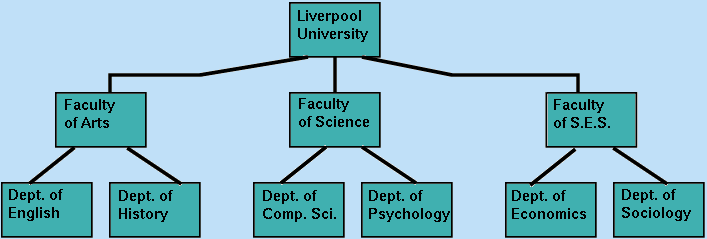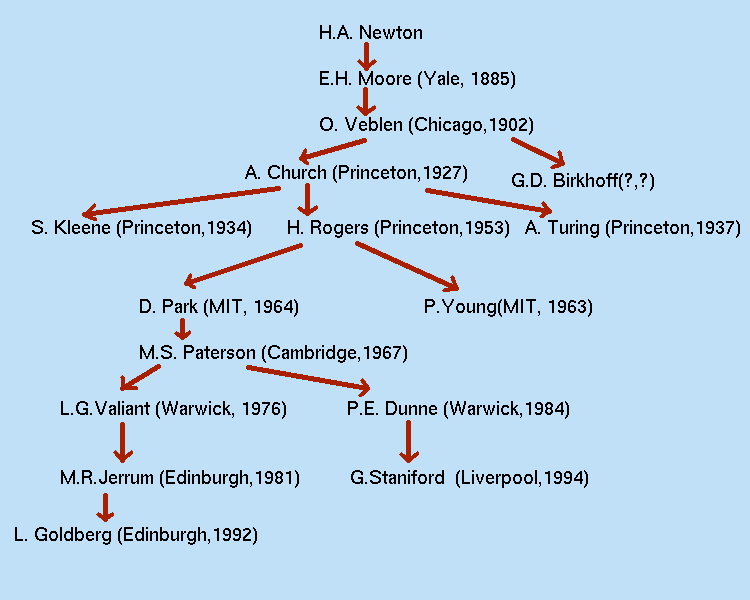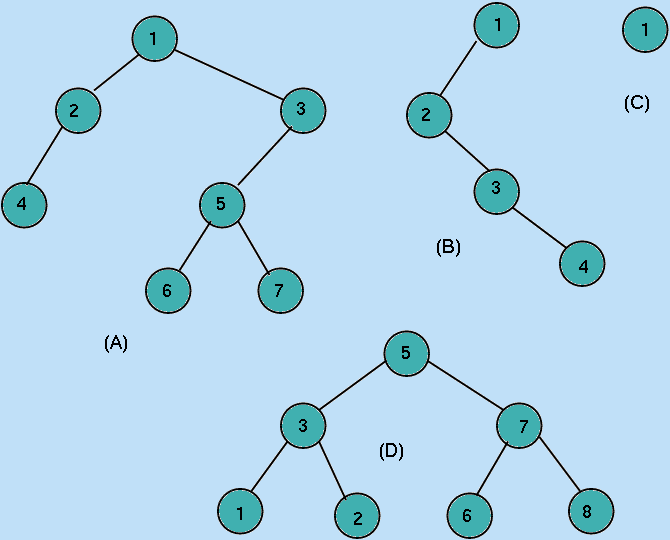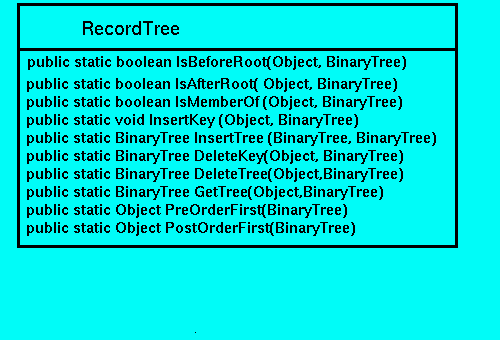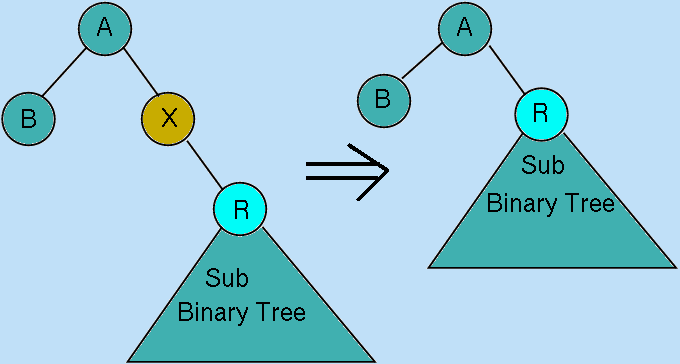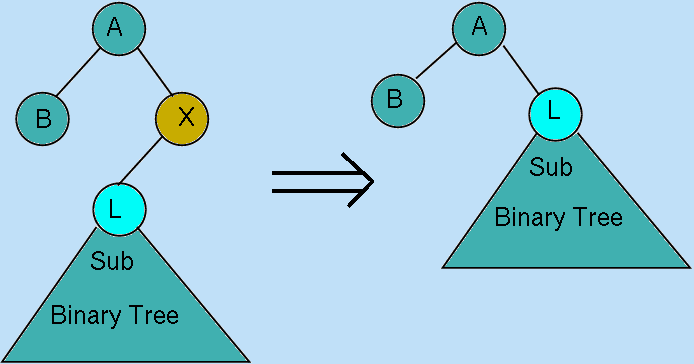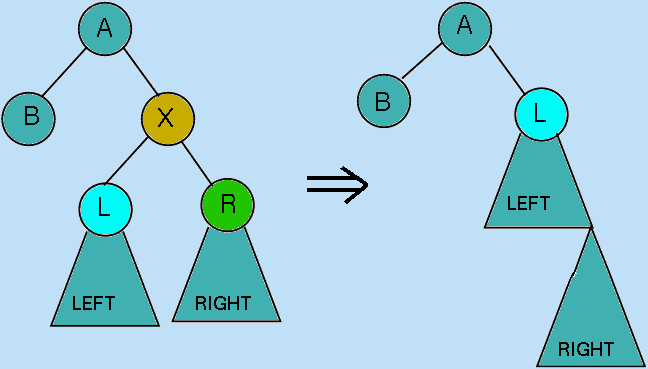|
Definition:
A Binary Tree, T is recursively defined as follows:
|
Thus, all of the examples in Figure 10.3 below are binary trees:
Figure 10.3: Examples of Binary Trees
The structure in Figure 10.3(A) has a root labelled 1, with the root of its
Left sub-tree labelled 2 and its
Right sub-tree labelled 3. In Figure 10.3(B),
the Right sub-tree of the root is the empty tree, and in
Figure 10.3(C), both sub-trees of the root are empty. The structure in Figure 10.4(D) is
an example of what is sometimes called a
complete binary tree: one which contains exactly
2k-1 nodes where k is the number of nodes encountered on
any path from the root to a lowest level node (i.e. one with no children).
The examples in Figure 10.4, however, are not binary trees
Figure 10.4: Examples of structures which are not Binary Trees
In Figure 10.4(A) and Figure 10.4(B) there are nodes with more than 2 children;
Figure 10.4(C) is not a tree structure (in terms of our definition, the left and
right sub-trees of the root can be viewed as not containing distinct sets of nodes).
It should be noted that Linked Lists can be seen as
a special type of (Binary) tree, i.e. one in which every node has at most one child, and that
Binary Trees (in fact Trees in general)
can be viewed as a special type of Graph
The latter viewpoint is useful when characterising properties shared by all trees. In this
context (using the graph-theoretic terminology of Lecture 4,
so that tree nodes are referred to as graph vertices, and links from parent
to child nodes are referred to as graph edges), it is not difficult to show
that all of the definitions below are equivalent:
|
Tree Properties
An n-vertex graph G(V,E) is a tree if:
- There is a path of edges between any two vertices and there are exactly n-1 edges.
- There is a path of edges between any two vertices and there are no cycles in G.
- There is a unique path between any two vertices.
|
|
Tree Attributes
- A leaf of a tree is a node that has no children.
- The depth of a tree is the maximum number of
nodes encountered on the unique path from the root to a leaf node.
|
Tree Properties and Attributes
Looking at the examples in Figures 10.1, 10.2, and 10.3:
- The tree in Figure 10.1 has 10 nodes, 8 of which are leaves. Its depth is 3.
- The tree in Figure 10.2 has 16 nodes, 6 of which are leaves. Its depth is 10.
- The tree in Figure 10.3(A) has 7 nodes, 3 of which are leaves. Its depth is 4.
- The tree in Figure 10.3(B) has 4 nodes, 1 of which is a leaf. Its depth is 4.
- The tree in Figure 10.3(C) has 1 node which is a leaf. Its depth is 1.
- The tree in Figure 10.3(D) has 8 nodes, 4 of which are leaves. Its depth is 3.
3. A Binary Tree Class in Java
In this part we consider the realisation of a basic Binary Tree class within Java.
Later we shall develop this class in order to demonstrate how to maintain dynamically
a collection of records that are sorted according to a given key, i.e. we present
methods for adding and removing nodes from a binary tree so as always to be
able consistently to output the records stored in the order required.
As will be clear using a binary tree structure to perform tasks such as that developed
in Lecture 9, provides potentially very large saving in the time taken to
maintain the record organisation.
The recursive definition of a binary tree, motivates modelling
a binary tree using three fields:
- protected Object Root
- protected BinaryTree Left
- protected BinaryTree Right
We may use the default constructor in instantiating an instance of a BinaryTree
and then simply require Instance methods with which to set and obtain the values
of these fields. So, we have the Class diagram in Figure 10.5, in which
three further static methods are, also, included:
Figure 10.5: BinaryTree Class Diagram.
The three Class Methods return the number of nodes (SizeOf(T)), number of leaves (NumLeaves(T)),
and depth (DepthOf(T)), of the BinaryTree, T, given
as a parameter. This class is realised as in Figure 10.6.
// COMP102
// Example 15: Binary Trees
//
// Paul E. Dunne 1/12/99
//
public class BinaryTree
{
protected Object Root; // Tree Root
protected BinaryTree Left; // Pointer to Left Sub-tree
protected BinaryTree Right; // Pointer to Right Sub-tree
//*****************************************************
// Binary Tree Methods *
//*****************************************************
//
// Test is this tree contains no nodes
//
public boolean IsEmpty()
{
return (Root==null)&&(Left==null)&&(Right==null);
}
//*****************************************************
// Set and Obtain the Root of this BinaryTree *
//*****************************************************
public void SetRoot( Object root_val )
{
Root = root_val;
}
public Object GetRoot ()
{
return Root;
}
//*****************************************************
// Set the Left/Right Subtress of this BinaryTree *
//*****************************************************
public void SetLeft( BinaryTree L )
{
Left=L;
}
//
public void SetRight( BinaryTree R )
{
Right=R;
}
//*****************************************************
// Get the Left/Right Subtrees of this BinaryTree *
//*****************************************************
public BinaryTree GetLeft ()
{
return Left;
}
//
public BinaryTree GetRight()
{
return Right;
}
//*******************************************************//
// Calculate the number of nodes in a given BinaryTree. //
//*******************************************************//
public static int SizeOf( BinaryTree T )
{
if (T.IsEmpty())
return 0;
else
return 1 + SizeOf(T.GetLeft()) + SizeOf(T.GetRight());
}
//*******************************************************//
// Calculate the number of Leaves in a given BinaryTree*//
//*******************************************************//
public static int NumLeaves (BinaryTree T)
{
if (SizeOf(T) <= 1)
return SizeOf(T);
else
return NumLeaves(T.GetLeft()) + NumLeaves(T.GetRight());
}
//*******************************************************//
// Calculate the depth of nodes in a given BinaryTree. //
//*******************************************************//
public static int DepthOf (BinaryTree T)
{
if (SizeOf(T) <= 1)
return SizeOf(T);
else
return 1+Math.max( DepthOf(T.GetLeft()), DepthOf(T.GetRight()) );
}
}
|
Figure 10.6: BinaryTree Realisation.
4. Insertion, Deletion and Tree Traversal
One of the problems that is noticeable with LinkedLists as
a dynamic ADT for maintaining a collection of records sorted according
to some key field, is that as the collection increases in size, the typical time
to search for a record with a given key can become excessive.
Using a binary tree organisation can significantly cut down this time.
In this section we develop a set of methods, similar in spirit to those
we considered in the application of Lecture 9, that can be employed
to maintain a collection of records held within a binary tree
structure.
Before describing these we need to consider what is understood
by a data set being held in a `sorted order'
within a binary tree: the concept of sorting and ordering is easily
defined for the case of linear structures, such as linked lists or
arrays, binary trees, however, are non-linear.
Recall that the BinaryTree class contains three fields:
the Root with which arbitrary Objects may be referenced, and
the Left, Right fields which are themselves BinaryTree
instances. Suppose we have already defined (as was done in Lecture 9) a method
boolean IsBefore (Object X, Object Y)
that returns true if X precedes Y
and X and Y are different.
Using this method and the approach outlined below, will not only allow
a consistent definition of `sorted order' to be given for a BinaryTree object, but
also ensure that a sequence of Objects can be formed into a `sorted' tree structure and recovered
in a similar order.
Let,
X1, X2 ,. . ., Xi ,. . ., Xk
be a sequence of k instances of Objects (presumed to be of the
same class). The algorithm InsertKey, maintains a
BinaryTree instance, T, as follows:
public static void InsertKey (Object Key, BinaryTree T)
{
if (T is empty) // (This is only tree when the first Object (X1) appears.
{
Set the Root of T to be the Object Key;
Instantiate the Left and Right fields of T to be new BinaryTree instances.
}
else if (Key `is before' the Object held in the Root of T)
{
Recursively insert Key into the BinaryTree T.Left;
}
else if (Object held in the Root of T `is before' Key)
{
Recursively insert Key into the BinaryTree T.Right;
};
}
|
A fuller realisation of this algorithm (in Java) is given later. We now enumerate the set of methods
that will be used in maintaining a set of records held within a Binary Tree structure.
We utilise a class RecordTree to provide a set
of static methods for manipulating BinaryTree
instances. Its class diagram is given in Figure 10.7.
Figure 10.7: RecordTree Class Diagram.
Before we describe the purpose and realisation of these methods it is worthwhile to
stress an extremely important shared feature of how many operations on
binary tree structures may be realised.
The recursive definition of Binary Tree structure, provides
a simple, natural, and extremely powerful basis for implementing
all but the first two of the methods in the list. In essence
binary tree methods can almost always be described in terms of the template
in Figure 10.8, below:
|
- If the tree is empty { do something and finish}
- Carry out `some operation' on the Left sub-tree AND/OR
- Carry out `some operation' on the Right sub-tree AND/OR
- Process the Root of the tree.
|
Figure 10.8: General recursive framework for Binary Tree operations.
(where in the Left and Right sub-tree case, `some operation' will normally be a recursive
invocation of the method realised).
For example, the static method SizeOf(BinaryTree T),
calculate the number of nodes in a binary tree using,
- If the tree is empty {its size is 0};
- Calculate the number of nodes in the Left sub-tree; AND
- Calculate the number of nodes in the Right sub-tree; AND
- Add the two totals together with the number of nodes in the root (i.e. 1), returning the
final total as result.
Returning to the RecordTree class,
the functions provided by its methods are as follows:
- public static boolean IsBeforeRoot ( Object Key, BinaryTree T )
Compare the Key Object with the Root Object field
of the BinaryTree instance, T, returning true if Key precedes
T.Root.
- public static boolean IsAfterRoot ( Object Key, BinaryTree T )
Similarly,
compare the Key Object with the Root Object field
of the BinaryTree instance, T, returning true if Key succeeds
T.Root.
- public static boolean IsMemberOf( Object Key, BinaryTree T )
Test if the Key Object occurs in (i.e. is the Root field of
T or one of its sub-trees) the BinaryTree T.
- public static void InsertKey(Object Key, BinaryTree T)
Modify the BinaryTree T by inserting a node correspding to
the Object Key into it. As with our LinkedList
record scheme in Lecture 9, we do not allow the same Key to occur more than once in a
given BinaryTree instance.
- public static BinaryTree InsertTree(BinaryTree Add, BinaryTree T)
Similarly, insert the BinaryTree Add into T, again avoiding
occurrences of duplicate keys.
- public static BinaryTree DeleteKey(Object Key, BinaryTree T)
Return the structure of T resulting by removing the node corresponding to the
Object Key. It is assumed that
Key occurs at most once in
T. If Key does not occur, then T itself is returned.
- public static BinaryTree DeleteTree (Object Key, BinaryTree T)
Similarly, return the structure of T that results by removing the sub-tree whose
Root corresponds the Object Key.
- public static BinaryTree GetTree (Object Key, BinaryTree T)
Return the sub-tree of T whose Root corresponds to the Object Key.
If Key does not occur in T, the empty tree is returned.
- public static Object PreOrderFirst(BinaryTree T)
This and the following method will be dealt with later in the lecture.
- public static Object PostOrderFirst(BinaryTree T)
In order to give an indication of how a typical recursively controlled binary tree
method might be realised, we will concentrate on the 2 methods:
public static void InsertKey(Object Key, BinaryTree T)
public static BinaryTree DeleteKey(Object Key, BinaryTree T)
In realising the InsertKey method, the algorithm, given earlier
is straightforward to implement in terms of the binary tree instance methods
already described and the static methods of RecordTree,
i.e.,
//*********************************************//
// Insert a new Object into T, maintaining a *//
// Sorted ordering *//
//*********************************************//
public static void InsertKey(Object Key, BinaryTree T)
{
if (T.IsEmpty())
{
T.SetRoot(Key);
T.SetLeft(new BinaryTree());
T.SetRight(new BinaryTree());
}
else if ( IsBeforeRoot(Key,T) )
InsertKey(Key,T.GetLeft());
else if ( IsAfterRoot(Key,T) )
InsertKey(Key,T.GetRight());
}
|
Figure 10.9: Inserting a new Key into an ordered BinaryTree Instance
If we study this in terms of the `recursive template' of Figure 10.8: when the
tree is empty, inserting a new Key into this produces a tree with a single node
whose Root field is the Key and whose Left and Right sub-tree fields are empty
BinaryTree instances; otherwise the Key is compared with
the Object indicated by the Root field and recursively
inserted into the approriate T.Left or T.Right trees. Notice that
the realisation of the IsBefore(Object,Object)
method ensures that duplication will be avoided.
The processes required for deleting a node
ensuring that a correct ordering of the remaining nodes is maintained, is rather more
complicated than the corresponding operation on LinkedList structures.
The reason for this is that care must be taken not to eliminate the references
to the Left and Right tree of the node that is being deleted.
Suppose we have identified the node of the tree that should be deleted, i.e. the one
such that its Root field is equal to the Key.
There are three cases which are straightforward to deal with:
- This node is a leaf: the Left and Right trees are empty, so the node can be replaced
by a new empty BinaryTree instance.
Figure 10.10(a): Deleting Node X (X is a leaf)
- The Left sub-tree is an empty BinaryTree instance:
the BinaryTree instance comprising the Right sub-tree can
be returned as the result.
Figure 10.10(b): Deleting Node X (X has an empty Left sub-tree)
- The Right sub-tree is an empty Binarytree instance:
the BinaryTree instance comprising the Left sub-tree can
be returned as the result.
Figure 10.10(c): Deleting Node X (X has an empty Right sub-tree)
This leaves only the case where both sub-trees are not empty BinaryTree
instances. What form should the replacement ordered tree take in this case?
From the ordering regime that has been employed it is known that every
value held in the Left sub-tree PRECEDES every value held in the Right sub-tree,
therefore if the BinaryTree formed by inserting the Right
subtree into the Left subtree is constructed, this will
be a correct structure with which to replace the BinaryTree instance
whose Root field we wish to delete.
